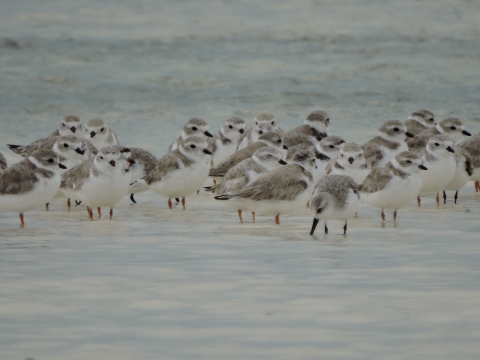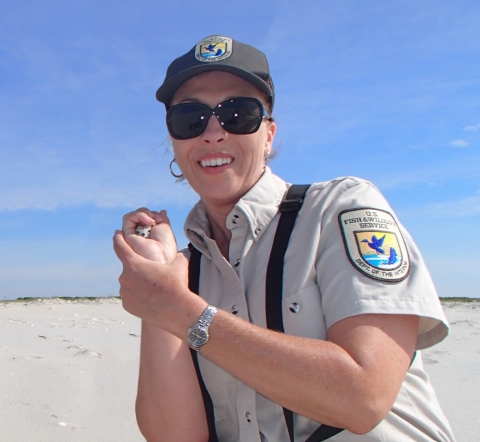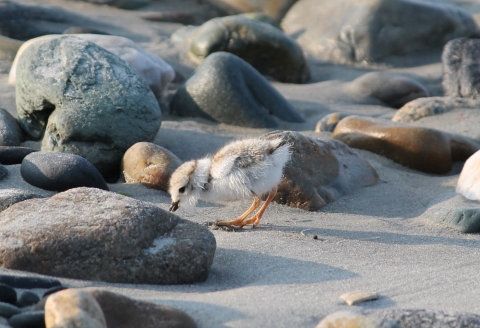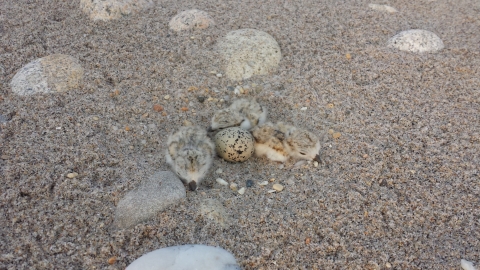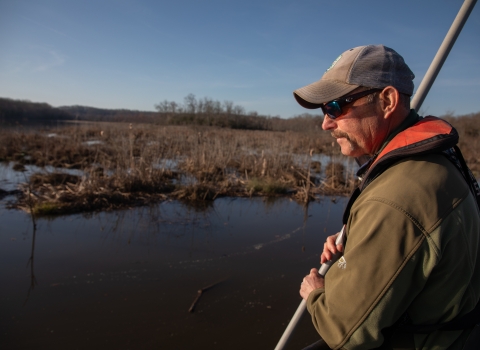Every spring I eagerly await the arrival of the first piping plovers to the sandy shores of South Jersey. The birds have been wintering in the Bahamas and the southern U.S., but once they reach Jersey, they are a certain sign of the warm summer to come. Long sunny days, gardening and ice cream at the boardwalk will soon be here.
I also think of the challenges the summer will bring to this pint-sized, sandy-colored bird. Life at the beach for many of us is a dream, or at least a state of mind, but it can be fraught with danger for plovers. And the birds need support from people to get through this season.
Refuges for wildlife
What do plovers need to thrive? Just like people, they need access to food and spaces that are safe. But unlike us, they have some very specific needs. I work at Edwin B. Forsythe National Wildlife Refuge in southern New Jersey. The refuge protects nearly 48,000 acres for the benefit of people and wildlife, but just a few hundred acres are vital nesting habitat for piping plovers. This species has been protected as threatened under the Endangered Species Act since 1986. Prior to that and ever since, biologists have spent a lot of time working to ensure the species’ survival.
Piping plovers (or PIPLs as we sometimes refer to them) once thrived on their own, but they now need us to survive. Our love of the beach resulted in the alteration of nearly all habitat on the Eastern Seaboard where PIPL nested. Houses with sweeping views of the ocean were built in dunes that were previously allowed to be washed over by the ocean. Communities cropped up east of the back bays, and pressure mounted to stabilize the beach to reduce flooding. That development inhibits beaches from naturally evolving, and has since eliminated much of the habitat PIPLs came to depend upon. Recreational vehicles created tracks that trap chicks, and beach rakes swept up burgeoning vegetation (which PIPL use for cover) and foraging habitat. Dogs running free made some beaches inhospitable for birds. Litter and garbage at buildings near the beach provided food for mammals that prey on plovers.
What is left for plovers is a patchwork of sandy spaces with varying degrees of protection and of myriad sizes. And the population has reacted accordingly. When the bird was listed, there were about 100 pairs in New Jersey. While our population grew for many years, it’s back down to around 100 pairs. There are only a few truly vibrant breeding areas — all on land managed by either the state or federal government — and it’s not enough. Combined, in recent years these areas have held 80 percent of plovers in the state. The remaining pairs nest on beaches owned by local governments or non-profit organizations, often in areas used by beach-goers throughout the summer. The success of plovers requires both nest monitoring and protection at all of these sites.
Plover management takes a team
Biologists, lawmakers, conservation officers, land managers, private landowners, community organizations, and every person that loves to spend time at the beach need to work together to find ways to meet the needs of plovers while still meeting our needs. For the birds, we need to basically do two things: identify habitat that is suitable for plovers and then keep it as undisturbed as possible.
As we say in biology, “habitat is where it’s at.” Plovers need broad expanses of beach in the fore-dune area full of shells to build nests, with small mounds to hide behind for cover. One of the best ways to obtain this type of habitat is by allowing the beach to roll, undulate and occasionally be washed by churning ocean waters. This happened during Hurricane Sandy, which caused destruction of homes for many people. The storm also flattened dunes on the refuge’s Holgate Beach. That might sound like a bad thing for the refuge, but a natural part of coastal systems is the change brought by storms. Excellent piping plover habitat resulted from the hurricane, and in 2019 we have more plover pairs on the refuge than we have had in decades.
We close the beach at Forsythe from April through August to ensure minimal disturbance. Only employees that track bird progress are permitted on the beach during nesting season. This eliminates uses of the beach that we all love but cause birds to run away and expend energy (kites and Frisbees are seen as a dangers, dogs chase birds, picnics attract nuisance animals). PIPL chicks forage on their own right away, but the parents need to show them where the food is. Ever wonder why tiny ‘cotton balls with legs’ are spotted running back and forth along the water’s edge? Their food — small bugs and worms plucked from the ground – only occurs in areas of wet sand. Regular trips to the water’s edge and back to the safety of the dunes are needed – with no vehicles getting in the way!
Another disturbance of great concern for breeding plovers is that they are seen as meals by would-be predators. Data suggest that if select predators (which are abundant and common) are not removed, the birds will not be successful — eggs, chicks and even adults have been eaten by raccoon, fox, and mink at Forsythe. As a consequence, adults may abandon their brood if a mate is lost. Generally, we remove 5–10 animals each spring. Even with these early-season removals, mammals ate plover chicks before they could fly on their own this summer. While we do not relish undertaking these limited predator removals, we know plovers will not successfully nest on our beaches if we do not take that action.
So when will we be done managing for plovers?
As a nation, we have decided to place value on sites that are so special they warrant protection that is overseen by professionals trained in biology, ecology and land management. We have also passed laws that protect rare plants and animals from further harm to them or their habitat, including the Endangered Species Act. We know we can have a coast with beaches for people and those for plovers. A healthy plover population means we have high-quality beaches, and those beaches help protect us from storm surge.
It might seem frustrating to know that some species like plovers may never be truly independent of help from people. But another way to think about it is that we created this scenario, so it only makes sense that we are part of the solution. Biologists and managers would love a day to come when we can move on from plover management, shake the sand out of our shoes, and spend time working on other species that need our support. In some respects, plovers are lucky: they can literally pick up and fly away at any time. They get to winter in the Carolinas, Florida or even the Bahamas! But, the reality is that they are very limited to where they can survive — it has to be safe, generally undisturbed, and food must be available.
The good news is that there is an extensive team of highly skilled, passionate biologists, educators and partners that are doing everything they can to ensure piping plovers (and other beach birds like terns, skimmers and oystercatchers) thrive in New Jersey and all coastal states. In fact, over the last few decades plover populations have substantially grown in places like Massachusetts and Connecticut. We are using incredible technology to track birds, including on the wintering grounds, and we are learning more each year. The refuge is committed to continuing plover management and educating the public about the importance of the species. Our goal is to recover the species to a healthy population, but in the meantime we will be doing everything we can to support them on the Jersey Shore.

